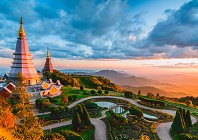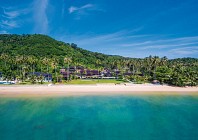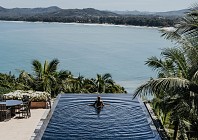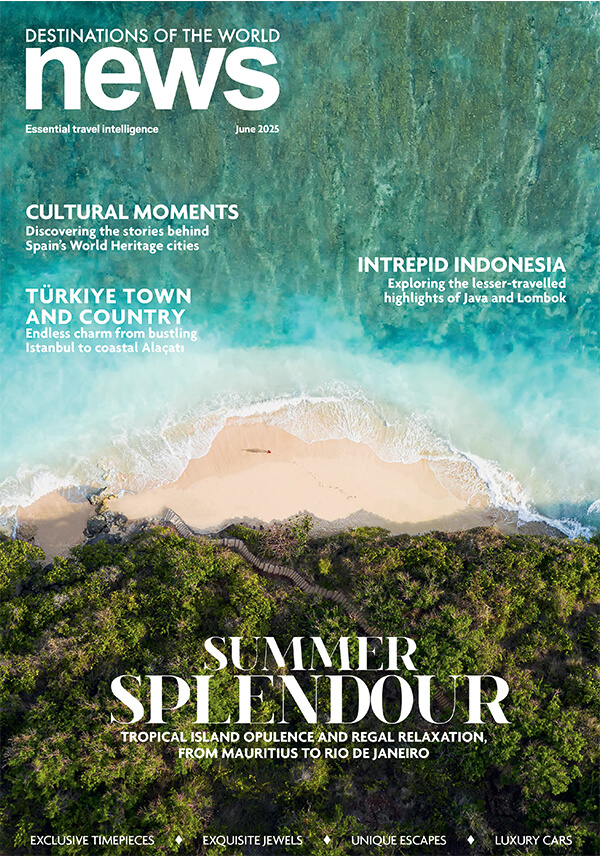There’s little to disturb the peace and quiet along Krabi’s epic coastline, except for the swaying of palms and the occasional cry of a monkey. Limestone cliffs shape the horizon and crystal- clear waves lap at the white sand beaches that line the shore, inviting visitors to lay back and take it easy for a few days.
But unlike some of Thailand’s other popular destinations, Krabi keeps its treasures secret, which is probably why it’s so unspoiled. Even though it’s just an hour’s flight from the Thai capital ith national carrier Thai Airways, Krabi is a world away from Bangkok.
The civil unrest that shook the capital earlier this year didn’t disrupt the peace and quiet in Krabi, but the economic fallout and the damage done to Thailand’s tourism industry has had a knock-on effect around the country, with international tourism arrivals falling by 13 per cent in May.
Thailand suffered the same fate as many Southeast Asian countries that rely on tourism as a primary source of income last year, when international visitor arrivals fell by about three per cent to 14m.
A rebound in the first three months of 2010 was a sign that things were improving, but the positive start to the year was relatively short-lived, since the political turmoil that rocked the Thai capital had a knock-on effect on the rest of the country.
Nevertheless, those visitors who did make it to Krabi were rewarded with quieter beaches, cheaper hotels and a more exclusive experience.
THE COOL OF KRABI
When people talk about Krabi, they’re rarely referring to Krabi Town, which is a sprawling port with its fair share of charm, but less of the breathtaking beauty that characterises the rest of the southern province.
Don’t expect glitzy shopping malls and five-star boutiques; Krabi is a far cry from some of the other resort destinations in Thailand. Here, visitors come to get away from it all, visit the outlying islands and soak up the atmosphere.
Krabi Province encompasses popular spots such as Tub Kaek Beach to the west, the laid-back Ao Nang Beach, the stunning Railay Peninsular, and the 130 or so tropical islands that lie offshore in the shallow waters of the Andaman Sea.
Most of the area between Tub Kaek and the airport is serviced by a modern tarmac road, which weaves between towering limestone cliffs with vegetation cascading down to the roadside, and winds its way through fields of coconut palms, oranges, mangoes and coffee, as well as rubber palms – the region’s principal export – and the occasional small town or village.
Driving in Krabi feels more like you’re heading into undiscovered territory than driving through the heart of one of Thailand’s most popular escapes.
Tub Kaek, about 40 minutes from the airport, is home to a few boutique hotels, including the Amari Vogue Krabi and the Tubkaak Beach Resort Krabi – the two most popular Krabi hotels on TripAdvisor.
The views out into the Andaman Sea from Tuk Kaek’s beaches are breathtaking – giant rock formations known as karsts jut out of the water along the horizon like a row of broken teeth, while the lush greenery onshore fills the oxygen-rich air with the exotic perfume of the rainforest.
Although there are several sizeable properties in the area, they’re nearly all carefully hidden away behind a wall of jungle, and since there’s not a single building in the area that’s higher than the treetops, the whole province feels unspoiled and pristine.
A thirty-minute drive east along the coastal road brings you to Ao Nang; the provincial tourist hub with the laid-back atmosphere of a smaller town, which provides visitors with a base from which to explore the surrounding area.
Not far from Ao Nang, several operators run elephant safaris in the rainforest; a reminder of the days of old when Krabi enjoyed a healthy trade in elephants with India.
The elephant traders are long-gone, but half-day tours give visitors the chance to get up close and personal with the elephants as they explore the jungle, chasing glimpses of an exotic collection of birds and monkeys.
The jungle also provides some fantastic opportunities for trekking and exploring, if you do feel compelled to leave the beach at any point, and a number of tour operators offer climbing and kayaking trips on and around the karsts that litter the coast.
The abundance of fish in the crystal-clear waters makes snorkelling another popular activity for the restless. Although much of the coral reef around the islands was badly damaged in the 2004 tsunami, the tropical waters of the Andaman Sea are still filled with colourful fish and exotic sea life.
Ao Nang is popular for its beaches, sunset bars, massage huts and guesthouses, but after an afternoon on the beach in Tub Kaek, the motive for our visit was more primeval.
The restaurants in the ‘Soi Seafood’, seafood street, are said to serve up some of the best fish in Thailand, and we weren’t going to pass up an opportunity to try it out for ourselves.
From an open-air terrace overlooking the sun as it set behind the cliffs, we enjoyed the best bowl of tom yum goong soup we’d ever tasted.
Fragrant with the scent of galangal, lemongrass and Kaffir limes, and thick with freshly caught prawns – its colour was a deep orange thanks to the chilli – it delivered a powerful kick. The deliciously plump seabass with cherry tomatoes was so fresh, we could still taste the sea water.
THE ISLANDS
Although the roads around Krabi are in perfect condition and most hotels offer extremely comfortable transportation – think air-conditioned mini-buses – the tarmac isn’t necessarily the most effective means of getting around in Krabi.
The waterways between Krabi and Phuket are speckled with vessels of all shapes and sizes, from the ubiquitous ‘longtail’ boats – colourful canoes with an oily diesel-powered engine stuck on the back – to the sleek hulls of sailing yachts, modern catamarans and shiny speed boats.
Each town or village has a pier where boats can dock, and many of the hotels have their own pier or at least a small stretch of beach where smaller boats can pull up to allow guests to hop on and off.
You have to get up seriously early in the morning if you want to sample Krabi at its most picturesque, so we were already standing on the pier in Krabi waiting for our speedboat transfer to take us to Centara Grand Beach Resort and Villas at 7.30 the next morning, watching the longtails line up on the beach as their captains shared the morning’s news.
Sheltered in its own private bay, the Centara has a Bond villain’s hideaway feel, with buildings creeping up the secluded hillside, and its own miniature version of the so-called ‘James Bond Island’ – the isolated limestone karst in nearby Phang Nga Bay that featured in the 1974 Bond classic The Man with the Golden Gun.
Local laws forbid beaches to place sun-loungers directly on the beach, so many of the top-end properties have beach-facing gardens where guests can still enjoy the stunning views without having to slum it on the sand.
The same laws prevent hotels from building fixed pontoons on their beaches, so like many properties in the area, the Centara has a floating pier from which guests arrive and depart.
Waddling down the floating pier, we boarded a sleek speed boat that would have impressed 007 himself, and set off on a half-day tour of the stunning islands.
Jetting off into the gulf between Krabi and Phuket and the 130 or so islands in between, island tours whisk visitors across the still waters of the Andaman Sea, passing the sheer faces of the cliffs, and catching glimpses of the many secluded beaches the area is famous for.
There are hundreds of spots to stop and explore, but most organised tours follow a fixed itinerary that usually includes Koh Mai Pai (Bamboo Island), Ao Ling (Monkey Bay), Viking Cave and snorkelling at Hin Klang, before arriving at the highlight of the trip, Maya Bay on Koh Phi Phi Leh.
Former hangout of Leonardo DiCaprio and his co-stars during the filming of the 2000 blockbuster The Beach, Maya Bay is now a must on every visitor’s itinerary, though it does mean sharing the beach with several boat-loads of tourists, all looking for the same once-in-a-lifetime experience.
Despite the large numbers of visitors, Maya Bay remains one of the world’s most breathtaking spots. Surrounded by sheer limestone cliffs with vegetation cascading down to the water, the emerald green and turquoise bay screams ‘secret hideaway’.
If you close your ears to the multitude of foreign languages walking up and down the beach and close your eyes for a second, the white powder beach and its ring of palm trees feels like your own private garden.
At the far end of the beach, we discovered a small cabin selling cold beer and refreshments and four locals playing guitar, who explained that the beach was usually much busier (it was already busy) with the peak tourism season between November and April.
By the time we’d cooled down in the shade of a rocky overhang, the beach had become slightly quieter and ours was the only speedboat left in the bay, with just a small swarm of long- tails remaining.
If you don’t like the idea of sharing your beach experience with hundreds of other tourists, we’d suggest chartering your own speedboat or yacht from one of the many operators in Krabi or Phuket (or bring your own) and arriving on the beach first thing in the morning, then spending the rest of your day visiting the lesser-known beaches until you find your own secluded spot for lunch.
Although reaching Koh Phi Phi Leh is much easier in reality than it is in The Beach, the entire island is part of a protected national park, and only a handful of permits for overnight stays are issued each day.
If you’re keen to get a permit, a clutch of tour operators in Koh Phi Phi Don – or ‘Phi Phi’ as it’s known by locals – offer exclusive overnight packages for just US$62, but this isn’t a typical five-star experience.
The luxury is in experiencing something few others can, and spending a night under the stars on one of the world’s best beaches.
PHI PHI AND RAILAY
Although it was devastated by the 2004 tsunami, business in Phi Phi was recovering well until the combined effect of the economic crisis, the political unrest in Bangkok and the tourist low season took its toll this year.
Reminders of the tragedy that left more than 230,000 people dead line the beaches throughout the Andaman Coast – blue and white signs indicating the nearest tsunami evacuation route, which also instructs visitors to follow the signs to the nearest patch of high ground at the first signs of an earthquake.
Split in two with a thin waist in the middle, where every other doorway is a bar, guest house or shop, offering organised excursions, tattoos or hair braiding, Phi Phi is a particular favourite for backpackers, who come to enjoy the extremely laid-back atmosphere.
Accommodation on the island is mainly two- and three-star, but villas make a perfect island escape for a couple of nights, even if they’re not up to the luxury of those on the mainland in Krabi and Phuket.
Since Phi Phi is much closer to Maya than Phuket, it is also a strategic stopover if you plan to beat the tour boats out to Maya Bay first thing in the morning.
The harbour occupies the southern half of the island, while the northern half is where you’ll find the oh-so-white beaches and laid-back beach bars for which Phi Phi is famous. Wealthy travellers, young couples and grubby backpackers rub shoulders on Phi Phi’s sugary white northern beach, all brought together by the desire to escape the everyday and enjoy a slice of paradise.
On the 45-minute return journey from Phi Phi to the mainland, we stopped off at Railay; a tiny peninsular of land only accessible by boat, and secreting some of the area’s best hotels and beaches. In the heart of this rocky outcrop is Rayavadee – occupying a prime position on the Peninsular, it’s the only hotel with direct access to the stunning Phra Nang Beach.
Completely invisible from the outside, nestled between three beaches and buried under a blanket of jungle, this all-villa property can claim to be the only hotel in the area that offers guests the thrill of having their dinner in a cave – The Groto.
The exclusive property shares the top end of Krabi’s hotel market with the Ritz-Carlton Reserve in Tub Kaek, both of which command starting rates in excess of US$700 per night.
As the sun sank in the west, Rayadavee’s speedboat took us back to the pier in Krabi Town. On the boat, a couple of lawyers from New Zealand who had spent the last two weeks at Rayavadee, explained how much the area had changed since their last visit 10 years ago.
“This entire stretch of beach was empty except for a few huts selling beers and coconuts,”
they explained as the boat pulled out of the wide bay on the eastern flank of Railay, which is now dotted with countless small hotels and guesthouses. “It hasn’t exactly spoiled it, but it’s amazing how much a place can change in such a short period.”
When we asked them if they’d been out to the islands during this visit, they shared a little secret with us: “When you’re staying somewhere like this and you have everything you need right here, there’s not really much of an incentive to go anywhere else. It’s about getting away from it all for a little while, and that’s exactly what this place offers.”
Each of the picturesque spots we visited around Krabi had the same beguiling effect, whether a hotel beach, a secluded bay, or a shady spot under the cliffs on a paradise island.
The entire area captures the imagination and time slows down; when you’re gazing out on a cloudless sky, watching the boats idle across the calm waters of the Andaman Sea, wondering just how and when the giant limestone karsts were formed, you don’t really need to think about much else at all.
WHERE TO STAY
TUB KAEK/KLONG MUANG
AMARI VOGUE KRABI
The most westerly hotel in the Krabi area, the Amari Vogue is one of the region’s favourites. The 57-room boutique property stretches from the lush palm-covered slope to the coast, where the gentle waves of the Andaman Sea lap against the white sandy beach. With a stunning view that captures a panorama of limestone karsts, fishing boats and waves, the hotel’s Bellini restaurant is a favourite spot for evening sundowners and some of the best seafood in Krabi. The Silvara Spa features two spa suites for romantic escapes and a VIP room with Vichy shower.
We love… sharing the pool with a herd of elephants and the breathtaking views.
www.amari.com/vogue
SHERATON KRABI BEACH RESORT
If it’s a hammock strung between palm trees above oh-so-white sand you’re after, it’s worth checking out this long-time Krabi favourite. With lush gardens cascading down to the edge of the 1.8km Klong Muong Beach, a Mandara Spa, 246 elegantly appointed rooms and an eclectic mix of restaurants and bars, the Sheraton in Krabi has become something of an institution.
We love… the huge beach and the sound of trees swaying in the breeze.
www.starwoodhotels.com
SOFITEL KRABI PHOKEETHRA GOLF AND SPA RESORT
Set within grounds that encompass a nine-hole golf course, the Sofitel property is a newcomer to Krabi that’s packed with charming Colonial elements complimented by modern touches. As well as 276 rooms, the hotel features three restaurants, five bars, a 7,000sq m swimming pool and a Turkish bath.
We love… the magnificent and colonial open-plan lobby.
www.sofitel.com
PHULAU BAY RITZ-CARLTON RESERVE
The most expensive hotel in mainland Krabi, Phulau Bay is also the first property in Ritz-Carlton’s exclusive ‘Reserve’ collection. Despite its curious exterior (it would look quite at home in Arizona) the interiors of the 54-room boutique hotel are exquisitely designed and the ESPA at Phulay Bay is the epitome of calm.
We love… the 24-hour butler service.
www.ritzcarlton.com
AO NANG/RAILAY
RAYAVADEE
This outstanding all-villa property is nestled in the heart of the jungle-covered Railay Peninsular, surrounded by three beaches and hemmed in by limestone cliffs. With 98 two-storey pavilions and four private villas, the accommodation ranges from ‘very nice indeed’ to all-out luxury. This has to be the most picturesque spot in Krabi.
We love… all of it: the swinging sofas in the pavilions; the beach views from the private villas; the monkeys; and the lush tropical atmosphere.
www.rayavadee.com
CENTARA GRAND BEACH RESORT AND VILLAS KRABI
Set in its own private Pai Plong Bay, the Centara resembles a Bond villain’s lair, with accommodation pouring down from the surrounding hillsides to the 500m-wide beach. The 192-room and villa property is popular with celebrities and Thai politicians, who come to enjoy the privacy and seclusion.
We love… the views from the hot tubs on the terrace of the Spa Deluxe suites and the fact that this remote hotel can only be reached by boat.
www.centarahotelsresorts.com
ANANTARA SI KAO RESORT, TRANG
One of the province’s most remote outposts of luxury, the Anantara Si Kao Resort, Trang is only an hour away from Krabi Airport, but a million miles away from life as we know it. Designed as a haven where wellbeing and tranquillity matter most, the Anantara resort is situated in a private islet, making it perfect romantic hideaway.
We love… the Bill Bensley-designed gardens and the absolute peace and quiet.
www.sikao.anantara.com
SIX SENSES HIDEAWAY YAO NOI
Buried in a sea of green on Koh Yao Noi Island in Phang Nga Bay, ‘hideaway’ is an entirely accurate description of this super-exclusive resort. With unrivalled views of the innumerable islands poking out of the Andaman Sea, the Six Senses resort is steeped in authenticity. Created from locally sourced materials and adhering to local design philosophy, the 54-villa property blends lovingly into the landscape, while its two exclusive top-end products – 645sq m ‘The Retreat’ and the 1,473sq m ‘Hill Top Reserve’ – are fit for royalty.
We love… the private waterslide and lookout tower at The Hill Top Reserve.
www.sixsenses.com
GETTING THERE
THAI AIRWAYS
Thai Airways flies from Bangkok to 100 destinations around the world and offers regular connections for onwards gflights to other destinations in Asia. The national carrier is also the quickest way of getting around whilst you're in Thailand, with regular flights to 10 domestic airports, including three daily flights between Bangkok and Krabi.
Check the Thai Airways website for more information
GETTING AROUND
AO NANG
There is no public taxi service in Ao Nang, so unless you’re staying within walking distance of the corniche, it’s better to plan your return before you set out from the hotel.
Most of the properties in Tub Kaek operate shuttle buses that stop at pre-arranged locations several times a day, but if you plan to stay out late into the evening, you’ll either need to arrange a pick-up with your hotel beforehand, or opt for the more adventurous, if less comfortable option – the Songthaew.
Somewhere between a tuk tuk and a pick-up truck, the Songthaew is not the most luxurious form of transport, but it does offer a view of Thailand that you can’t see from the inside of an air-conditioned mini-bus. They usually operate as shuttle buses running regular trips along specific routes, but its easy and cheap enough to charter your own.
The Songthaew drivers who gather at the pick-up points dotted along the corniche will be happy to take you to most places in Krabi. Prices for trips to many of the popular spots and hotels are displayed on a billboard, so you’re unlikely to get ripped off by an unscrupulous driver.
But be advised: the Songthaews are operated by a ‘private company’ which fixes the prices, so don’t bother trying to haggle with the drivers, even if you think the rates are a little on the high side. These ‘private companies’, which are rife in Thailand, are know by less discreet locals as the ‘taxi mafia’.












